
 GitBucket
GitBucket
Multihoming in MbedOS
Table of contents
- Revision history.
- Introduction.
- System architecture and high-level design.
- Detailed design.
- MbedOS networking class diagram extension proposal.
- Simplified LWIP and EMAC.
- LWIPInterface changes.
- EMACInterface and EMAC driver.
- L3IPInterface and L3IP driver.
- Memory manager.
- Network default interface construction.
- Adding interface.
- Removing interface.
- Connecting Ethernet or Wifi.
- Disconnecting Ethernet or Wifi.
- Connecting Cellular.
- Disconnecting Cellular.
- Addressing.
- LWIP IP core.
- Network stack interface.
- Sockets changes.
- DNS changes.
- Usage scenario.
Revision history
| Revision | Date | Authors | Mbed OS version | Comments |
| 1.0 | 25 September 2018 | Tymoteusz Bloch | 5.11 | Initial revision |
Introduction
Overview and background
This document refers to mutlihoming for MbedOS ARM CortexM based embedded devices. Multihoming is the way of connecting device to more than one network interface. This can be done in order to increase reliability or performance.
Under normal operating condition embedded ip stack is connected to only one network driver. In many situations , it can be useful to connect an embedded device to multiple networks, to increase reliability (if a one network link fails, data can still be routed through the remaining networks) and to improve performance (depending on the destination, it is more efficient to route through multiple networks ).
Requirements and assumptions
To use multihoming embedded device board must be equipped with more than one network interface, driver and physical medium device. It can be a combination of ethernet, wifi, cellular modules as well as the same type multiple devices eg. two ethernet physical devices.
System architecture and high-level design
Architecture
Mbed OS network functionality is implemented inside features module.
High level view is on picture below

For connectivity MbedOS uses Netsocket module. It contains :
- sockets
- DNS
- TCP/UDP
- network interfaces
- IP stacks
- glue logic between IP stacks and network interfaces
MbedOS support following IP stacks :
- LWIP
- Nanostack
This design refers to only LWIP multihoming support so Nanostack will be omitted.
Component interaction
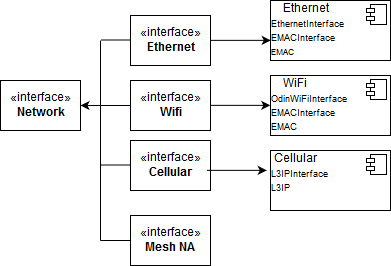
Detailed design
MbedOS networking class diagram extension proposal
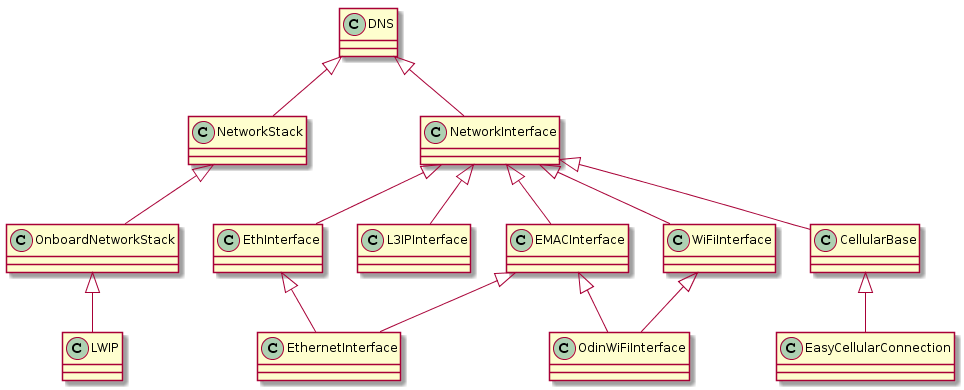
Simplified LWIP and EMAC

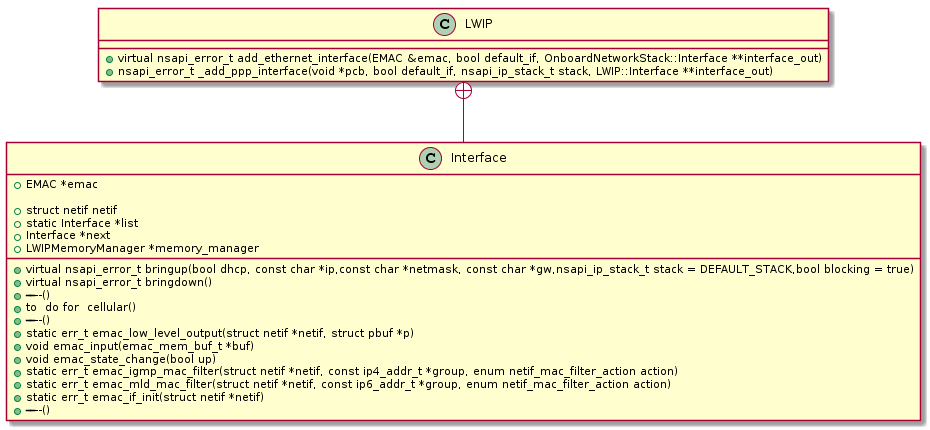
NetworkInterface *net; net = NetworkInterface::get_default_instance(); net->connect();
EMACInterface::connect will call:
- Stack -> add interface. - Stack::Interface ->bringup.
LWIPInterface changes
LWIP and is a top class responsible for LWIP network stack implementation in Mbed OS. LWIP/inner Interface class view is shown below. For better readability view is simplified.
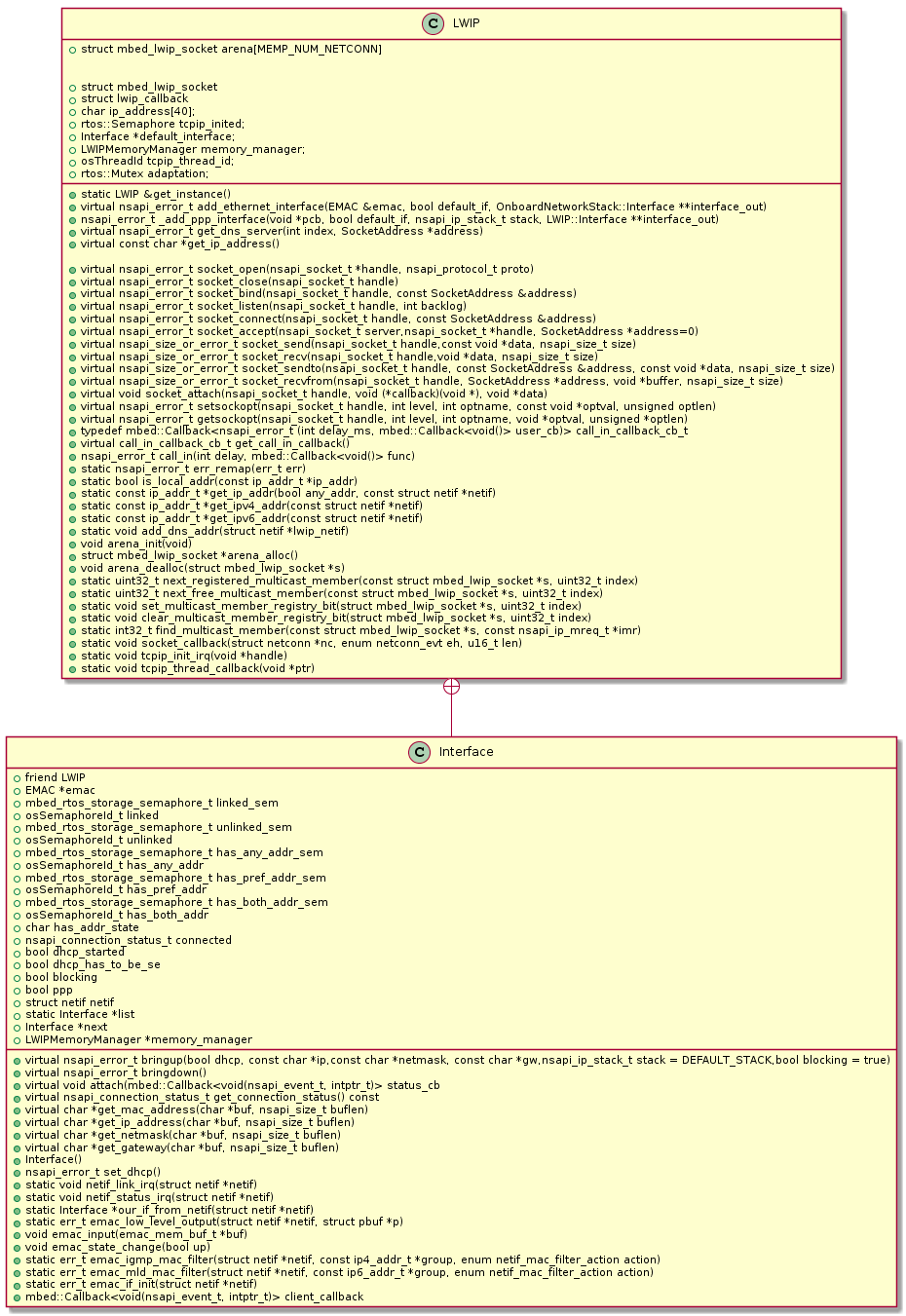
It's existing EMAC only version.
For clear view all members from LWIP/inner Interface are removed except EMAC related ones which are important from multi interface point of view.
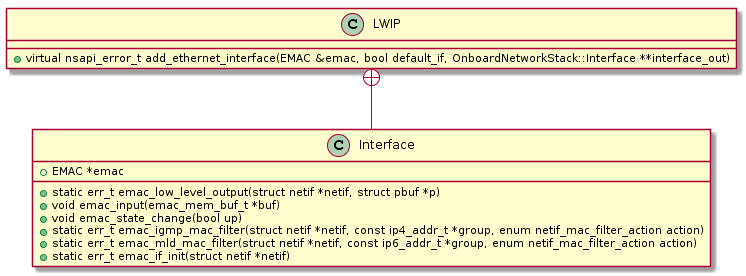
Those members are defined in LWIPInterfaceEMAC.cpp module. To use non EMAC drivers for cellular new members must be add. Lwip/Interface after extension is shown below.
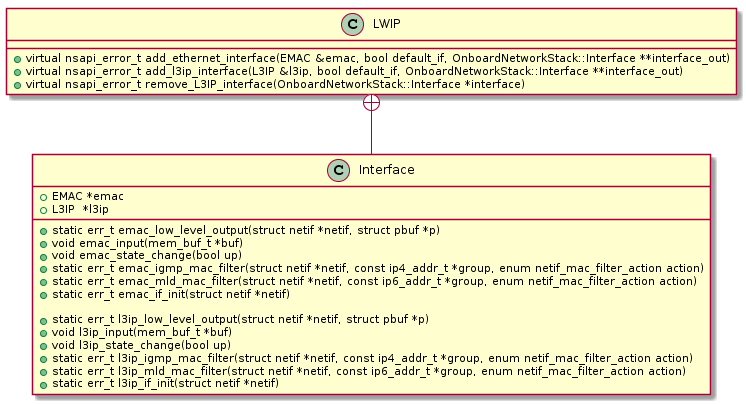
New L3IP related members will be defined in LWIPInterfaceL3IP.cpp module.
EMACInterface and EMAC driver

EMAC driver class should be used to abstract low level access to networking hardware All operations receive a void * hw pointer which an EMAC device provides when it is registered with a stack.
Existing EMAC class pure virtual definitions are shown below and must be overrided by target HW dedicated class driver derived from it.
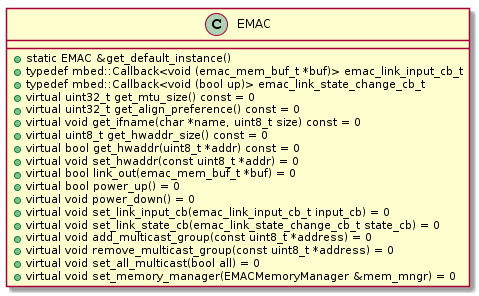
L3IPInterface and L3IP driver
L3IPInterface is new helper class dedicated to cellular connection. It based on existing EMACInterface and looks similar to it. However class methods have different implementation eg connect calls lwip::add_l3ip_interface() to add the interface instead of lwip::add_ethernet_interface. Currently the existing interface does not support destruct and remove drivers. So remove/destruct functionality is proposed to implement.
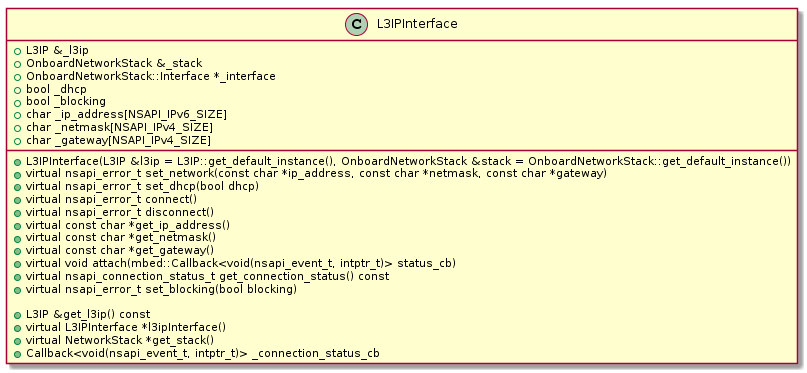
L3IP driver abstract class ia also based on EMAC class it also looks similar but is bound to cellular driver. 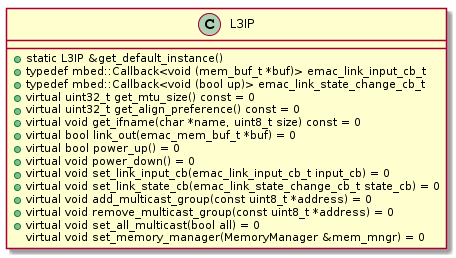
Memory manager
Currently there is memory manager dedicated to ethernet. It does not require changes however should be renamed from EMACMemoryManager to non confusing generic name like NetStackMemoryManager. Also memory buffer emac_mem_buf_t should folow this change to just net_stack_mem_buf_t.
Network default interface construction
Mbed OS support automated factories for default interface.
It depends on JSON configuration customized for particular target HW.
To instantiate it ::get_default_instance must be invoked on user desired interface type.
The top-level NetworkInterface use the following parameter
MBED_CONF_TARGET_NETWORK_DEFAULT_INTERFACE_TYPE for creating proper one :
- (ETHERNET ) EthInterface ::get_default_instance()
- (CELLULAR ) CellularBase ::get_default_instance()
- (WIFI ) WiFiInterface::get_default_instance()
- (MESH ) MeshInterface::get_default_instance()
Code for automated construction is in NetwokInterfaceDefaults.cpp module.
Adding interface
Since automated factory suport creation only one default interface, others must be constructed and added to LWIP manually.
For ethernet/wifi first new interface, EMACInterface helper and EMAC driver must be instantiated. For this connection types constructors are already implemented
EthernetInterface(EMAC &emac = EMAC::get_default_instance(),
OnboardNetworkStack &stack = OnboardNetworkStack::get_default_instance()) : EMACInterface(emac, stack) { }
or
OdinWiFiInterface(OdinWiFiEMAC &emac = OdinWiFiEMAC::get_instance(), OnboardNetworkStack &stack = OnboardNetworkStack::get_default_instance());
For cellular the situation is a little bit different due no support any ethernet like interfaces (ethernet,wlan). In this case constructor looks like below and is not yet implemented. This is new code proposal for new clases L3IPInterface and L3IP.
L3IPInterface(L3IP &l3ip = L3IP::get_default_instance(),OnboardNetworkStack &stack = OnboardNetworkStack::get_default_instance());
Regardless of interface type LWIP must be informed about new low level interface. This can be done by calling connect() method on proper helper class( EMACInterface or L3IPInterface). Connect adds new network interface and then sets up a connection on LWIP stack with bringup() method.
First it registers a network interface with the IP stack. Connects EMAC/L3IP layer with the IP stack and initializes all the required infrastructure. This function should be called only once for each available interface.
For ethernet/wifi its already implemented as:
LWIP::add_ethernet_interface(EMAC &emac, bool default_if, OnboardNetworkStack::Interface **interface_out)
Cellular connection doesn't support it yet. This is new feature. Proposal is shown below
LWIP::add_l3ip_interface(L3IP &l3ip, bool default_if, OnboardNetworkStack::Interface **interface_out)
Both methods have the same purpose but must differ in implementation due to cellular handles layer 2 differently and doesn't support any ethernet like interfaces (ethernet,wlan) and ARP.
Important part of addition new network interface is configuring LWIP struct called netif. This is the core part of LWIP. Simplifed more readable form (removed comments and preprocesors directives) is shown below.
netif is a generic data structure used for all lwIP network interfaces.
struct netif {
struct netif *next;
ip_addr_t ip_addr;
ip_addr_t netmask;
ip_addr_t gw;
ip_addr_t ip6_addr[LWIP_IPV6_NUM_ADDRESSES];
u8_t ip6_addr_state[LWIP_IPV6_NUM_ADDRESSES];
u32_t ip6_addr_valid_life[LWIP_IPV6_NUM_ADDRESSES];
u32_t ip6_addr_pref_life[LWIP_IPV6_NUM_ADDRESSES];
netif_input_fn input;
netif_output_fn output;
netif_linkoutput_fn linkoutput;
netif_output_ip6_fn output_ip6;
netif_status_callback_fn status_callback;
netif_status_callback_fn link_callback;
netif_status_callback_fn remove_callback;
void *state;
u8_t ip6_autoconfig_enabled;
const char hostname; u16_t chksum_flags; u16_t mtu;
u8_t hwaddr_len;
u8_t hwaddr[NETIF_MAX_HWADDR_LEN]; u8_t flags; char name[2]; u8_t num; netif_igmp_mac_filter_fn igmp_mac_filter; netif_mld_mac_filter_fn mld_mac_filter; u8_t addr_hint; u16_t loop_cnt_current; };
Existing member name[2] can be used to bind netif to socket. It is get with EMAC class member get_ifname from hw driver and have unique 2 char in length name.
Currently following names exists:
"en" ethernet "wl" wifi "l6" mesh "lo" loopback "pp" ppp
etc. For cellular it can be "cl"
Two character name string is concatenated with 8 bit value containing index which is incremented on each netif addition eg "wl0". If no multiple interfaces of one type "en0", "en1","en2" ... exists, name[2] member is sufficient to distinguish between different interface types like wifi, ethernet and cellular.
This netif struct uses handlers passed by
- (emac/l3ip)_low_level_output - (emac/l3ip)_input - (emac/l3ip)_state_change - (emac/l3ip)_igmp_mac_filter - (emac/l3ip)_mld_mac_filter - (emac/l3ip)_if_init
for bounding
-received data from driver to LWIP input handler -LWIP outgoing data to driver for tramsmiting -status callback from device driver -filters settings
From our point of view important function pointers are: -netif_output_fn output
-netif_linkoutput_fn linkoutput
From LWIP documentation we can read.
"output" is called by the IP module when it wants to send a packet on the interface. It first resolves the hardware address, then sends the packet. For ethernet physical layer, this is usually etharp_output().
"linkoutput" is called by ethernet_output() when it wants to send a packet on the interface. This function outputs the pbuf as-is on the link medium.
ARP in used in ethernet and wifi but for Cellular modem output must be bound to low level write handler. In case of cellular this is done by PPP over serial module (PPPOS) and currently is bound to pppos_netif_output with proper IP4/IP6 flag. This writes data to cellular modem UART based file handler. Due to different implementation of PPPOS "linkoutput" is not used for cellular.
To add all params to new netif following function must be called. This is the part of LWIP stack.
struct netif netif_add(struct netif netif, const ip4_addr_t ipaddr, const ip4_addr_t netmask, const ip4_addr_t gw, void state, netif_init_fn init, netif_input_fn input)
Removing interface
To remove interface proper method must be called
LWIP::remove_L3IP_interface(OnboardNetworkStack::Interface *interface)
Currently the EMACInterface does not support remove and EMAC drivers do not support destruct however implementation of remove/destruct functionality is considered for EMAC interface/drivers.
Connecting Ethernet or Wifi
EMACInterface is constructed with EMAC driver and (default) onboard network stack.
When EMACInterface::connect() is called it calls the LWIP::add_ethernet_interface() from lwip and after that lwip bringup() which activates the interface on lwip.
Disconnecting Ethernet or Wifi
EMACInterface::disconnect() will bring the interface down.
Connecting Cellular
L3IPInterface is constructed with L3IP driver and (default) onboard network stack.
When L3IPInterface::connect() is called it will call the LWIP::add_l3ip_interface() from lwip and after that lwip bringup() which activates the interface on lwip as in EMACInterface.
Disconnecting Cellular
L3IPInterface::disconnect() will bring the interface down.
Its destructor will call the LWIP::L3IP_remove_interface() and remove itself from lwip/lwip *netif.
Addressing
IP address can provided as LWIP::Interface::bringup() parameter as a static IP or DHCP. If DHCP flag is true than address is set ansynchronously as negotiation finish. Currently static address change after LWIP::Interface::bringup() is not used but there is proper setting member implemented for DHCP so it can be used for static IP change. This is open issue.
For L3IPInterface IPv6 unique identifier for construction link local address can be used similarly as in PPP. Both SLAAC and DHCP can be used. This is also open issue.
LWIP IP core
All outgoing packets regardles of TCP,UDP or RAW are procesed by
ip(4\6)_output_if_opt_src in LWIP IP module.
EMAC based outgoing traffic for ethernet and wifi
For this interface \ip_output_if_opt_src calls netif->output bound for low level ARP (ethernet) and proceed netif->linkoutput bound for ethernet output driver function.
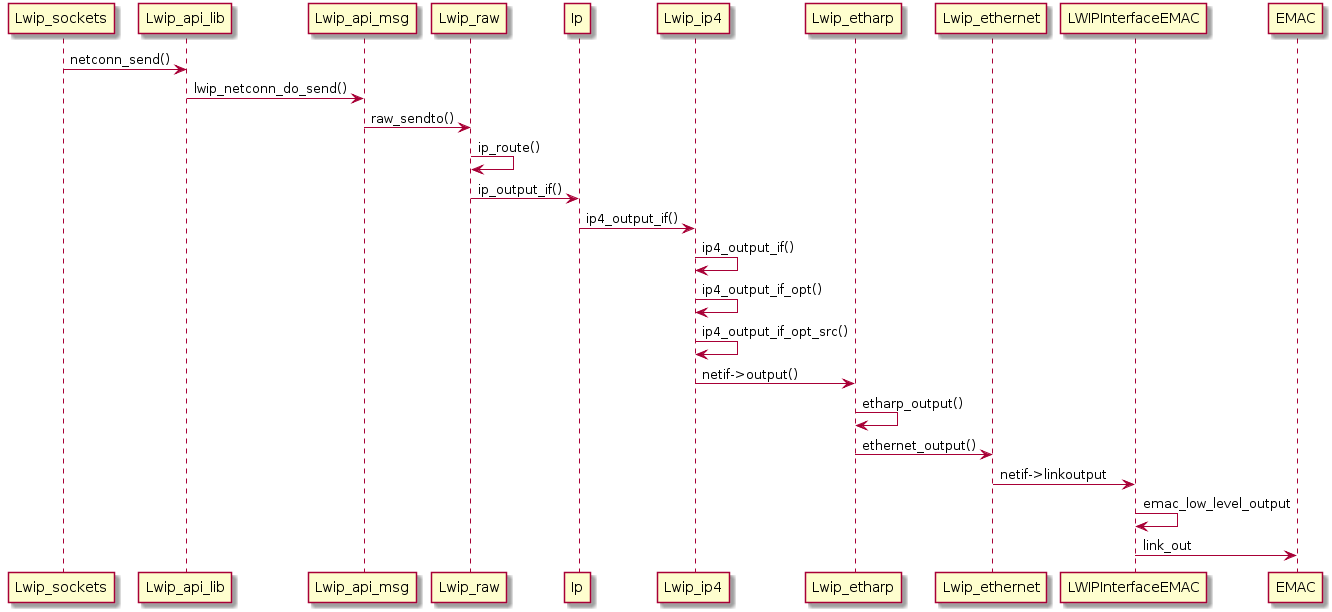
PPP based outgoing traffic for cellular
For cellular \ip_output_if_opt_src calls netif->output bound for low level ARP (ethernet) or PPP (cellular). 
EMAC based incoming traffic for ethernet and wifi

PPP based incoming traffic for cellular
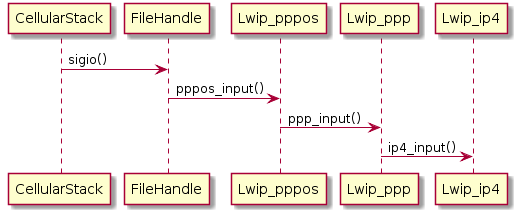
IP Route changes
This LWIP IP netif selection must be extended for routing to a specific netif instead default one.
Original ip4_route finds the appropriate network interface for a given IP address. It searches the list of network interfaces linearly. A match is found if the masked IP address of the network interface equals the masked IP address given to the function.
Passed param dest is the destination IP address for which to find the route New paremeter interface_name will be add to origin ip4_route for improved selection of desired netif.
Function returns the proper netif responsible for sending data to reach dest struct netif ip4_route(const ip4_addr_t dest) { struct netif *netif;
#if LWIP_MULTICAST_TX_OPTIONS
/* Use administratively selected interface for multicast by default */
if (ip4_addr_ismulticast(dest) && ip4_default_multicast_netif) {
return ip4_default_multicast_netif;
}
#endif /* LWIP_MULTICAST_TX_OPTIONS */
/* iterate through netifs */
for (netif = netif_list; netif != NULL; netif = netif->next) {
/* is the netif up, does it have a link and a valid address? */
if (netif_is_up(netif) && netif_is_link_up(netif) && !ip4_addr_isany_val(*netif_ip4_addr(netif))) {
/* network mask matches? */
if (ip4_addr_netcmp(dest, netif_ip4_addr(netif), netif_ip4_netmask(netif))) {
/* return netif on which to forward IP packet */
return netif;
}
/* gateway matches on a non broadcast interface? (i.e. peer in a point to point interface) */
if (((netif->flags & NETIF_FLAG_BROADCAST) == 0) && ip4_addr_cmp(dest, netif_ip4_gw(netif))) {
/* return netif on which to forward IP packet */
return netif;
}
}
}
#if LWIP_NETIF_LOOPBACK && !LWIP_HAVE_LOOPIF
/* loopif is disabled, looopback traffic is passed through any netif */
if (ip4_addr_isloopback(dest)) {
/* don't check for link on loopback traffic */
if (netif_default != NULL && netif_is_up(netif_default)) {
return netif_default;
}
/* default netif is not up, just use any netif for loopback traffic */
for (netif = netif_list; netif != NULL; netif = netif->next) {
if (netif_is_up(netif)) {
return netif;
}
}
return NULL;
}
#endif /* LWIP_NETIF_LOOPBACK && !LWIP_HAVE_LOOPIF */
#ifdef LWIP_HOOK_IP4_ROUTE_SRC
netif = LWIP_HOOK_IP4_ROUTE_SRC(dest, NULL);
if (netif != NULL) {
return netif;
}
#elif defined(LWIP_HOOK_IP4_ROUTE)
netif = LWIP_HOOK_IP4_ROUTE(dest);
if (netif != NULL) {
return netif;
}
#endif
if ((netif_default == NULL) || !netif_is_up(netif_default) || !netif_is_link_up(netif_default) ||
ip4_addr_isany_val(*netif_ip4_addr(netif_default))) {
/* No matching netif found and default netif is not usable.
If this is not good enough for you, use LWIP_HOOK_IP4_ROUTE() */
LWIP_DEBUGF(IP_DEBUG | LWIP_DBG_LEVEL_SERIOUS, ("ip4_route: No route to %"U16_F".%"U16_F".%"U16_F".%"U16_F"\n",
ip4_addr1_16(dest), ip4_addr2_16(dest), ip4_addr3_16(dest), ip4_addr4_16(dest)));
IP_STATS_INC(ip.rterr);
MIB2_STATS_INC(mib2.ipoutnoroutes);
return NULL;
}
return netif_default;
}
Network stack interface
For multiple netif's there is need to get DNS and IP addresses for an interface_name
Currently LWIP class members has no such parameter
get_ip_address() get_dns_server(int index, SocketAddress *address)
Also there is only pointer to one netif.
const struct netif *netif
So single netif should be replaced with array of netif pointers and members above must support to get IP and DNS from proper netif instance. Therefore new parameter "interface_name" should be added to get_dns_server and new member get_ip_address_if must be implemented to the NetworkInterface class.
get_ip_address_if(const char *interface_name)
get_dns_server(int index, SocketAddress *address, const char *interface_name)
From multihoming point of view it is desirable to get interface name and select any interface to default one at runtime. Therefore following new members need to be implemented
get_interface_name(char *interface_name)
set_as_default()
Netif interface_name should be added also to
dns_setserver(u8_t numdns, const ip_addr_t *dnsserver,const char *interface_name);
Sockets changes
For multihoming its needed to bind socket to desired network interface. To perform this new socket option must be add for socket class.
Member for LWIP stack specific socket option settings already exist in LWIP class. New option for socket binding to netif must be implemented inside:
nsapi_error_t LWIP::setsockopt(nsapi_socket_t handle, int level, int optname, const void *optval, unsigned optlen)
New socket option enum NSAPI_BIND_NETIF must be added.
Socket options after changes.
typedef enum nsapi_socket_option {
NSAPI_REUSEADDR, /*!< Allow bind to reuse local addresses */
NSAPI_KEEPALIVE, /*!< Enables sending of keepalive messages */
NSAPI_KEEPIDLE, /*!< Sets timeout value to initiate keepalive */
NSAPI_KEEPINTVL, /*!< Sets timeout value for keepalive */
NSAPI_LINGER, /*!< Keeps close from returning until queues empty */
NSAPI_SNDBUF, /*!< Sets send buffer size */
NSAPI_RCVBUF, /*!< Sets recv buffer size */
NSAPI_ADD_MEMBERSHIP, /*!< Add membership to multicast address */
NSAPI_DROP_MEMBERSHIP, /*!< Drop membership to multicast address */
NSAPI_BIND_NETIF, /*!< Biid nefit to socket */
} nsapi_socket_option_t;
LWIP specific socket is shown below
struct mbed_lwip_socket {
bool in_use;
struct netconn *conn;
struct netbuf *buf;
u16_t offset;
void (*cb)(void *);
void *data;
// Track multicast addresses subscribed to by this socket
nsapi_ip_mreq_t *multicast_memberships;
uint32_t multicast_memberships_count;
uint32_t multicast_memberships_registry;
};
New binding option should be placed into netconn struct. Descriptor for netconn is shown below.
struct netconn {
enum netconn_type type;
enum netconn_state state;
union {
struct ip_pcb *ip;
struct tcp_pcb *tcp;
struct udp_pcb *udp;
struct raw_pcb *raw;
} pcb;
err_t last_err;
sys_sem_t op_completed;
sys_mbox_t recvmbox;
sys_mbox_t acceptmbox;
int socket;
s32_t send_timeout;
int recv_timeout;
int recv_bufsize;
int recv_avail;
s16_t linger;
u8_t flags;
size_t write_offset;
struct api_msg *current_msg;
netconn_callback callback;
};
LWIP selects the proper netif on IP layer using ip_route.
Currently it uses only ip address as input parameter so choice is based on ip address only. To extend choice ctiteria also to interface index ip_route must be modified and must take desired interface_name as second argument. Therefore new member with information about netif interface_name bound to current socket should be placed in the common part of all PCB types.
#define IP_PCB \
ip_addr_t local_ip; \
ip_addr_t remote_ip; \
u8_t so_options; \
u8_t tos; \
u8_t ttl \
IP_PCB_ADDRHINT \
const char* interface_name -new member
New member char* interface_name should be add for binding socket to netif.
DNS changes
Currently in Nsapi_dns module there is only one array for 5 DNS server addresses.
static nsapi_addr_t dns_servers[DNS_SERVERS_SIZE] = {
{NSAPI_IPv4, {8, 8, 8, 8}}, // Google
{NSAPI_IPv4, {209, 244, 0, 3}}, // Level 3
{NSAPI_IPv4, {84, 200, 69, 80}}, // DNS.WATCH
{NSAPI_IPv6, {0x20,0x01, 0x48,0x60, 0x48,0x60, 0,0, // Google
0,0, 0,0, 0,0, 0x88,0x88}},
{NSAPI_IPv6, {0x20,0x01, 0x16,0x08, 0,0x10, 0,0x25, // DNS.WATCH
0,0, 0,0, 0x1c,0x04, 0xb1,0x2f}},
};
It would be desirable to add storage for interface specific DNS server addresses.
It can be done as below.
static nsapi_addr_t dns_servers[NETIF_INDEX][DNS_SERVERS_SIZE]
Add interface name as option to DNS query
To resolve IP address Netsocket module uses following functions
gethostbyname(const char *name, SocketAddress *address, nsapi_version_t version) nsapi_dns_query(NetworkStack *stack, const char *host, SocketAddress *address, nsapi_version_t version)
Query above uses only single dns_servers array described before. So it is also desired to add interface_name.
gethostbyname(const char *name, SocketAddress *address, nsapi_version_t version) nsapi_dns_query(NetworkStack *stack, const char *host, SocketAddress *address, nsapi_version_t version)
Second one nsapi_dns_query finally calls get_dns_server descirbed before. It has new parameter interface_name for proper netif selecting. So it would be logical to add also interface_name also to:
DNS::gethostbyname(const char *name, SocketAddress *address, nsapi_version_t version,const char* interface_name) nsapi_dns_query(NetworkStack *stack, const char *host, SocketAddress *address, nsapi_version_t version, const char* interface_name)
If async DNS query is used therefore UDP socket created for this purpose must be assigned for proper interface.
To perform this following UDPSocket base class member InternetSocket::setsockopt(int level, int optname, const void *optval, unsigned optlen) is used with parameters:
- optname NSAPI_BIND_NETIF - optval netif name
It finally calls stack specific implementation for socket option setting.
Usage scenario
Currently Mbed OS can construct only one default interface.
Its type depends on configuration file and MBED_CONF_TARGET_NETWORK_DEFAULT_INTERFACE_TYPE value.
Example of default network init code is shown below
NetworkInterface *net; net = NetworkInterface::get_default_instance(); net->connect();
If it's set to ETHERNET following code constructs EthInterface for ethernet EMAC.
If is set to WIFI WiFiInterface instance is constructed.
Similarly if type is CELLULAR EasyCellularConnection instance is created.
Second or third interface can be added manually
NetworkInterface *wifi_net; wifi_net = WiFiInterface::get_target_default_instance(); wifi_net->connect();
or
NetworkInterface *cellular_net; cellular_net = EasyCellularConnection::get_target_default_instance(); cellular_net->connect();
To construct network instance both Ethernet and WiFi uses EMAC and EMACInterface internally.
IP layer 3 interface can be created following way:
NetworkInterface *l3interface; l3interface =new L3IPInterface(L3IP::get_default_instance(), OnboardNetworkStack::get_default_instance()); l3interface->connect();